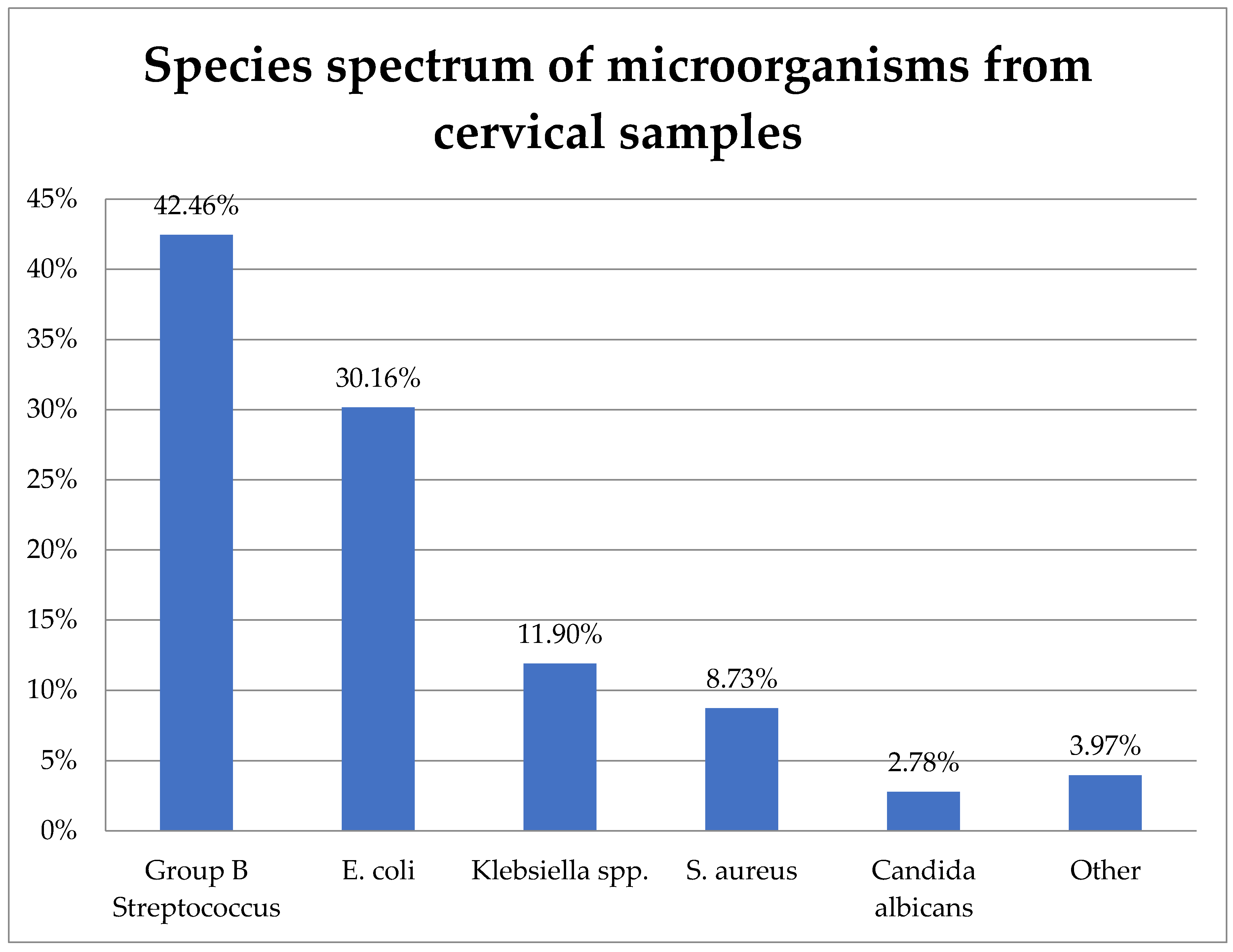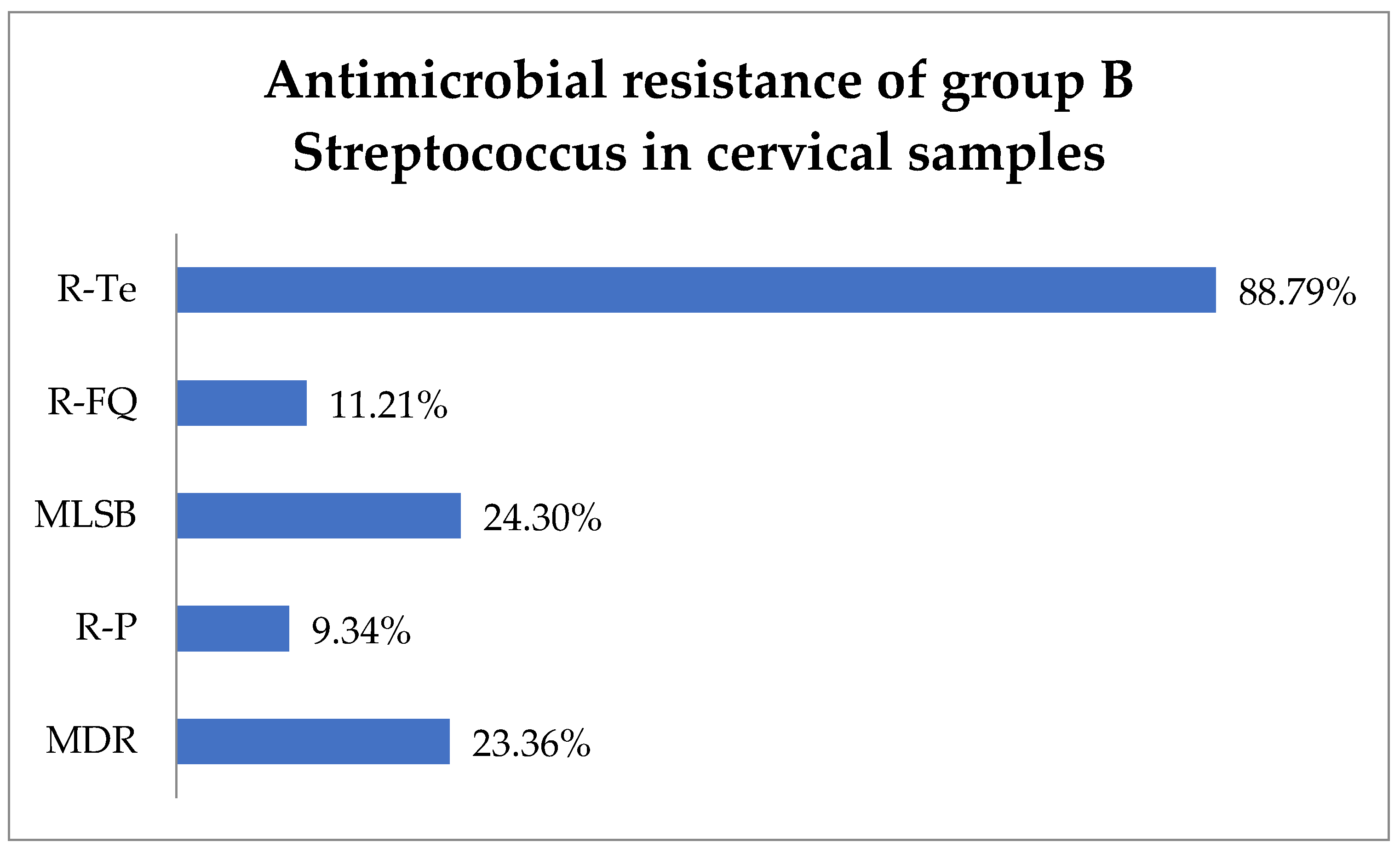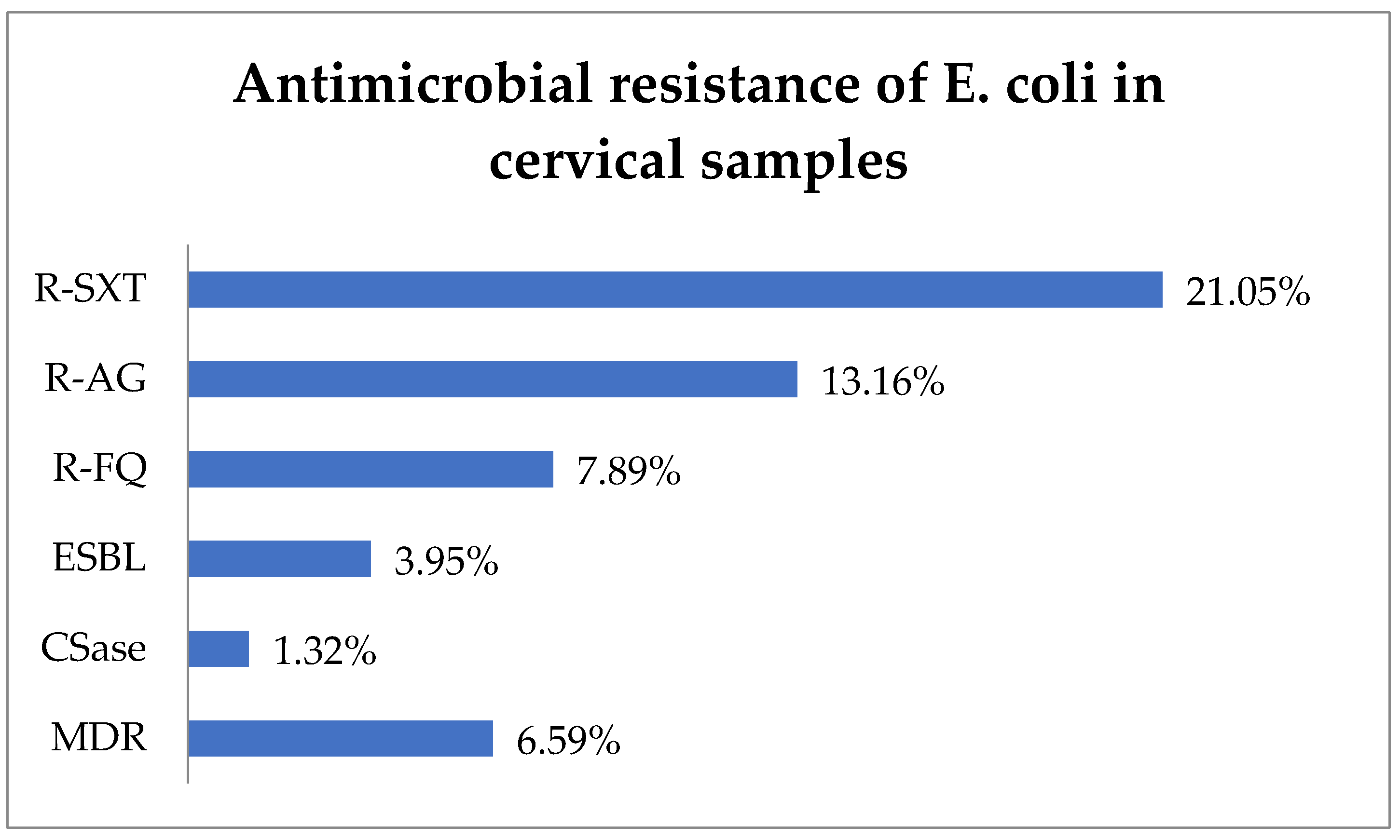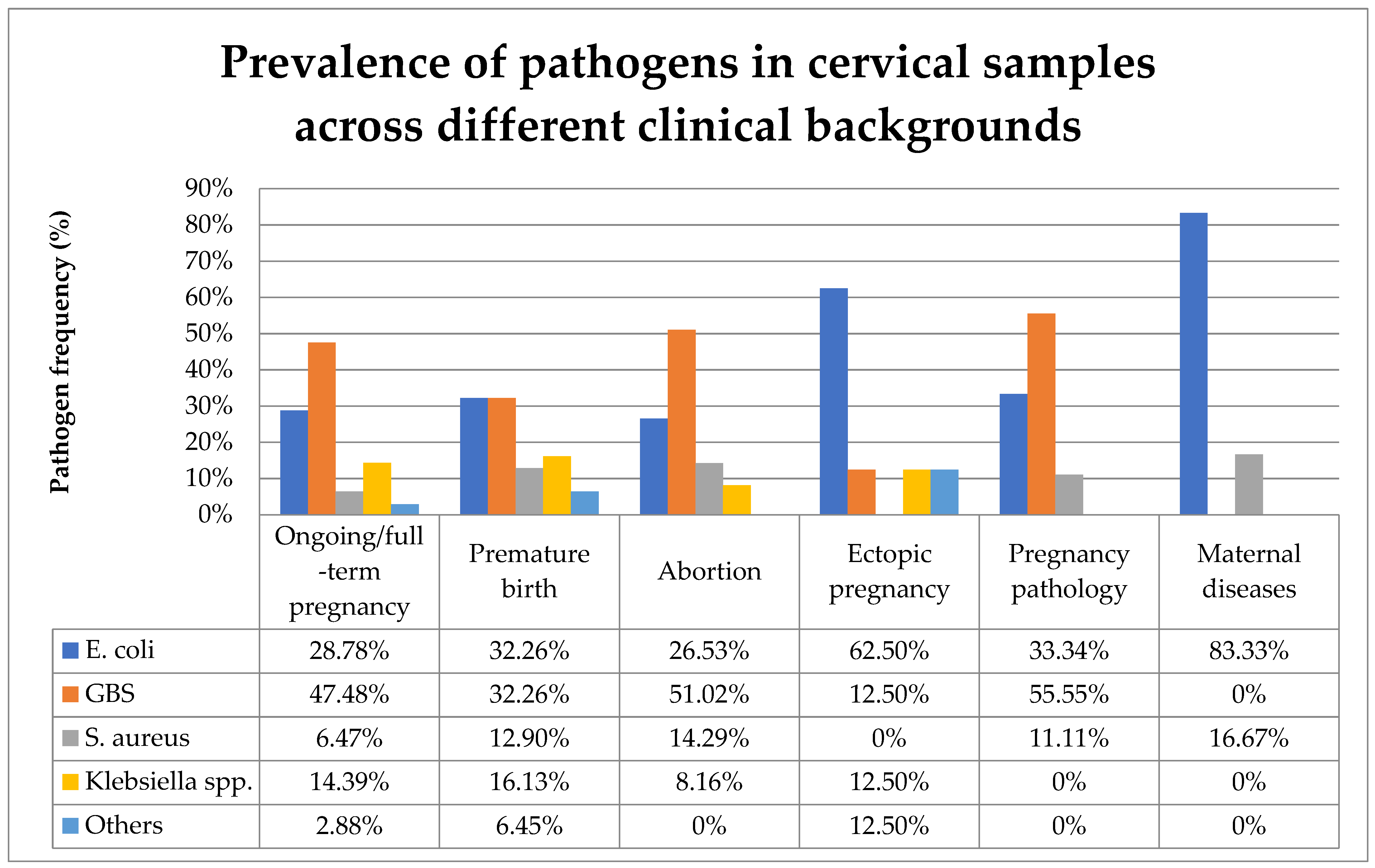Antimicrobial Resistance in Maternal Infections During Pregnancy
Abstract
1. Introduction
2. Materials and Methods
3. Results
3.1. Non-Cervical Samples
3.2. Cervical Samples
3.3. Group B Streptococcus
3.4. E. coli
3.5. K. pneumoniae
3.6. S. aureus
4. Discussions
The Limitations of the Study
5. Conclusions
Author Contributions
Funding
Institutional Review Board Statement
Informed Consent Statement
Data Availability Statement
Conflicts of Interest
References
- Teh, H.E.; Pung, C.K.; Arasoo, V.J.T.; Yap, P.S.X. A Comprehensive Analysis of the Female Vaginal Microbiome in Healthy Controls and Women with Reproductive Health Conditions Related to Ectopic Pregnancy. Br. J. Biomed. Sci. 2024, 80, 12098. [Google Scholar] [CrossRef] [PubMed]
- Chen, X.; Lu, Y.; Chen, T.; Li, R. The Female Vaginal Microbiome in Health and Bacterial Vaginosis. Front. Cell. Infect. Microbiol. 2021, 11, 631972. [Google Scholar]
- Saraf, V.S.; Sheikh, S.A.; Ahmad, A.; Gillevet, P.M.; Bokhari, H.; Javed, S. Vaginal microbiome: Normalcy vs dysbiosis. Arch. Microbiol. 2021, 203, 3793–3802. [Google Scholar] [CrossRef] [PubMed]
- Chopra, C.; Bhushan, I.; Mehta, M.; Koushal, T.; Gupta, A.; Sharma, S.; Kumar, M.; Khodor, S.A.; Sharma, S. Vaginal microbiome: Considerations for reproductive health. Future Microbiol. 2022, 17, 1501–1513. [Google Scholar] [CrossRef]
- Amabebe, E.; Anumba, D.O.C. The vaginal microenvironment: The physiologic role of lactobacilli. Front. Med. 2018, 5, 181. [Google Scholar]
- Chee, W.J.Y.; Chew, S.Y.; Than, L.T.L. Vaginal microbiota and the potential of Lactobacillus derivatives in maintaining vaginal health. Microb. Cell Fact. 2020, 19, 203. [Google Scholar] [CrossRef]
- Ncib, K.; Bahia, W.; Leban, N.; Mahdhi, A.; Trifa, F.; Mzoughi, R.; Haddad, A.; Jabeur, C.; Donders, G. Microbial Diversity and Pathogenic Properties of Microbiota Associated with Aerobic Vaginitis in Women with Recurrent Pregnancy Loss. Diagnostics 2022, 12, 2444. [Google Scholar] [CrossRef]
- Aagaard, K.; Riehle, K.; Ma, J.; Segata, N.; Mistretta, T.A.; Coarfa, C.; Raza, S.; Rosenbaum, S.; Van den Veyver, I.; Milosavljevic, A.; et al. A metagenomic approach to characterization of the vaginal microbiome signature in pregnancy. PLoS ONE 2012, 7, e36466. [Google Scholar]
- Shroff, S. Infectious Vaginitis, Cervicitis, and Pelvic Inflammatory Disease. Med. Clin. N. Am. 2023, 107, 299–315. [Google Scholar]
- Ma, X.; Wu, M.; Wang, C.; Li, H.; Fan, A.; Wang, Y.; Han, C.; Xue, F. The Pathogenesis of Prevalent Aerobic Bacteria in Aerobic Vaginitis and Adverse Pregnancy Outcomes: A Narrative Review. Reprod. Health 2022, 19, 21. [Google Scholar]
- Prasad, D.; Parween, S.; Kumari, K.; Singh, N. Prevalence, etiology, and associated symptoms of vaginal discharge during pregnancy in women seen in a tertiary care Hospital in Bihar. Cureus 2021, 13, e12700. [Google Scholar] [CrossRef]
- Elliyas, S.; Gaind, R.; Kanwal, S.K.; Singh, S.; Arya, S. Bacterial colonization of vagina in Indian women during labor and its association with puerperal and neonatal sepsis: A tertiary hospital study. Cureus 2021, 13, e13943. [Google Scholar] [PubMed]
- World Health Organization. WHO Recommendations for Prevention and Treatment of Maternal Peripartum Infections; World Health Organization: Geneva, Switzerland, 2015. [Google Scholar]
- Guidelinesprogramm AWMF-Regelwerk Leitlinien. Bacterial Vaginosis S2k-Guidelines. AWMF-Registernummer 015-028, Stand Juni 2023, Version 5.0. Available online: https://register.awmf.org/de/leitlinien/detail/015-028 (accessed on 23 March 2024).
- Norwitz, E.R.; Greenberg, J.A. Antibiotics in Pregnancy: Are They Safe? Rev. Obstet. Gynecol. 2009, 2, 135–136. [Google Scholar] [PubMed]
- Smaill, F.M.; Vazquez, J.C. Antibiotics for Asymptomatic Bacteriuria in Pregnancy. Cochrane Database Syst. Rev. 2019, 2019, CD000490. [Google Scholar] [PubMed]
- Prasanphanich, N.S.; Gregory, E.J.; Erickson, J.J.; Miller-Handley, H.; Kinder, J.M.; Way, S.S. Preconceptual Priming Overrides Susceptibility to Escherichia coli Systemic Infection During Pregnancy. mBio 2021, 12, e00002-21. [Google Scholar]
- Lawn, J.E.; Blencowe, H.; Mathers, C.; Cousens, S.N.; Oza, S.; You, D.; Lee, A.C.; Waiswa, P.; Lalli, M.; Bhutta, Z.; et al. Every Newborn: Progress, priorities, and potential beyond survival. Lancet 2014, 384, 189–205. [Google Scholar] [CrossRef]
- Matok, L.A.; Azrad, M.; Leshem, T.; Abuzahya, A.; Khamaisi, T.; Smolkin, T.; Peretz, A. Mother-to-Neonate Transmission of Antibiotic-Resistant Bacteria: A Cross-Sectional Study. Microorganisms 2021, 9, 1245. [Google Scholar] [CrossRef]
- Mei, C.; Yang, W.; Wei, X.; Wu, K.; Huang, D. The Unique Microbiome and Innate Immunity During Pregnancy. Front. Immunol. 2019, 10, 2886. [Google Scholar]
- Seale, A.C.; Bianchi-Jassir, F.; Russell, N.J.; Kohli-Lynch, M.; Tann, C.J.; Hall, J.; Madrid, L.; Blencowe, H.; Cousens, S.; Baker, C.J.; et al. Estimates of the Burden of Group B Streptococcal Disease Worldwide for Pregnant Women, Stillbirths, and Children. Clin. Infect. Dis. 2017, 65 (Suppl. S2), S200–S219. [Google Scholar] [CrossRef]
- Verani, J.R.; McGee, L.; Schrag, S.J. Division of Bacterial Diseases, National Center for Immunization and Respiratory Diseases, Centers for Disease Control and Prevention (CDC). Prevention of Perinatal Group B Streptococcal Disease: Revised Guidelines from CDC. MMWR Recomm. Rep. 2010, 59, 1–36. [Google Scholar]
- Russell, N.J.; Seale, A.C.; O’Driscoll, M.; O’Sullivan, C.; Bianchi-Jassir, F.; Gonzalez-Guarin, J.; Lawn, J.E.; Baker, C.J.; Bartlett, L.; Cutland, C.; et al. Maternal Colonization with Group B Streptococcus and Serotype Distribution Worldwide: Systematic Review and Meta-analyses. Clin. Infect. Dis. 2017, 65, S100–S111. [Google Scholar] [CrossRef] [PubMed]
- Hanna, M.; Noor, A. Streptococcus Group B. In StatPearls; StatPearls Publishing: Treasure Island, FL, USA, 2023. [Google Scholar] [PubMed]
- ACOG Committee. Prevention of Group B Streptococcal Early-Onset Disease in Newborns: ACOG Committee Opinion Summary, Number 782. Obstet Gynecol. 2019, 134, 1. [Google Scholar]
- Sabroske, E.M.; Iglesias, M.A.S.; Rench, M.; Moore, T.; Harvey, H.; Edwards, M.; Baker, C.J.; Flores, A.R. Evolving antibiotic resistance in Group B Streptococci causing invasive infant disease: 1970–2021. Pediatr. Res. 2023, 93, 2067–2071. [Google Scholar] [CrossRef]
- Moradi, Y.; Eshrati, B.; Motevalian, S.A.; Majidpour, A.; Baradaran, H.R. A Systematic Review and Meta-Analysis on the Prevalence of Escherichia coli and Extended-Spectrum β-Lactamase-Producing Escherichia coli in Pregnant Women. Arch. Gynecol. Obstet. 2021, 303, 363–379. [Google Scholar] [CrossRef]
- Mueller, M.; Tainter, C.R. Escherichia coli Infection. In StatPearls [Internet]; StatPearls Publishing: Treasure Island, FL, USA, 2024. Available online: https://www.ncbi.nlm.nih.gov/books/NBK564298/ (accessed on 23 March 2024).
- Wang, Z.L.; Fu, L.Y.; Xiong, Z.A.; Qin, Q.; Yu, T.H.; Wu, Y.T.; Hua, Y.Y.; Zhang, Y.H. Diagnosis and microecological characteristics of aerobic vaginitis in outpatients based on preformed enzymes. Taiwan J. Obstet. Gynecol. 2016, 55, 40–44. [Google Scholar] [CrossRef] [PubMed]
- Seliga-Siwecka, J.P.; Kornacka, M.K. Neonatal outcome of preterm infants born to mothers with abnormal genital tract colonisation and chorioamnionitis: A cohort study. Early Hum. Dev. 2013, 89, 271–275. [Google Scholar] [CrossRef]
- Leshem, E.; Maayan-Metzger, A.; Rahav, G.; Dolitzki, M.; Kuint, J.; Roytman, Y.B.; Goral, A.B.; Novikov, I.; Fluss, R.B.; Keller, N.; et al. Transmission of Staphylococcus aureus from Mothers to Newborns. Pediatr. Infect. Dis. J. 2012, 31, 360–363. [Google Scholar] [CrossRef]
- Ogura, J.; Inayama, Y.; Sasamoto, N.; Hirayama, T.; Ohara, T.; Sakai, M.; Suzuki, H.; Yasumoto, K.; Suginami, K.; Yamanoi, K. Vertical transmission of methicillin-resistant Staphylococcus aureus at delivery and its clinical impact: An observational, prospective cohort study. Acta Obs. Gynecol Scand. 2021, 100, 1986–1994. [Google Scholar] [CrossRef]
- Antimicrobial Resistance Surveillance in Europe 2023–2021 Data; Stockholm: European Centre for Disease Prevention and Control and World Health Organization; 2023. Cataloguing-in-Publication (CIP) data. Available online: http://apps.who.int/iris (accessed on 23 March 2024).
- Imade, P.E.; Izekor, P.E.; Eghafona, N.O.; Enabulele, O.I.; Ophori, E. Asymptomatic bacteriuria among pregnant women. N. Am. J. Med. Sci. 2010, 2, 263–266. [Google Scholar]
- Kim, J.H.; Lee, J.; Kim, D.H.; Park, J.Y.; Lee, H.; Kang, H.G.; Ahn, Y.H. Maternal Antibiotic Exposure During Pregnancy Is a Risk Factor for Community-Acquired Urinary Tract Infection Caused by Extended-Spectrum Beta-Lactamase-Producing Bacteria in Infants. Pediatr. Nephrol. 2022, 7, 163–170. [Google Scholar] [CrossRef]
- Hilty, M.; Betsch, B.Y.; Bögli-Stuber, K.; Heiniger, N.; Stadler, M.; Küffer, M.; Kronenberg, A.; Rohrer, C.; Aebi, S.; Endimiani, A.; et al. Transmission dynamics of extended-spectrum β-lactamase-producing Enterobacteriaceae in the tertiary care hospital and the household setting. Clin. Infect. Dis. Off. Publ. Infect. Dis. Soc. Am. 2012, 55, 967–975. [Google Scholar]
- Flokas, M.E.; Detsis, M.; Alevizakos, M.; Mylonakis, E. Prevalence of ESBL-producing Enterobacteriaceae in paediatric urinary tract infections: A systematic review and meta-analysis. J. Infect. 2016, 73, 547–557. [Google Scholar]
- Foessleitner, P.; Gasser, J.; Kiss, H.; Flunt, A.; Presterl, E.; Petricevic, L.; Farr, A. Vaginal Colonization of Extended-Spectrum Beta-Lactamase-Producing Bacteria During Pregnancy: An Observational Study. Eur. J. Obstet. Gynecol. Reprod. Biol. 2020, 246, 86–89. [Google Scholar]
- Styczynski, A.; Amin, M.B.; Hoque, K.I.; Parveen, S.; Pervez, A.F.M.; Zeba, D.; Akhter, A.; Pitchik, H.; Islam, M.A.; Hossain, M.I.; et al. Perinatal Colonization with Extended-Spectrum Beta-Lactamase-Producing and Carbapenem-Resistant Gram-Negative Bacteria: A Hospital-Based Cohort Study. Antimicrob. Resist. Infect. Control 2024, 13, 13. [Google Scholar]
- Gestels, T.; Vandenplas, Y. Prenatal and Perinatal Antibiotic Exposure and Long-Term Outcome. Pediatr. Gastroenterol. Hepatol. Nutr. 2023, 26, 135–145. [Google Scholar] [PubMed]
- Zimmermann, P.; Curtis, N. Effect of intrapartum antibiotics on the intestinal microbiota of infants: A systematic review. Arch Dis. Child Fetal Neonatal Ed. 2020, 105, 201–208. [Google Scholar] [CrossRef]
- Seif El Dahan, K.; Bejjani, J.; Nasrallah, A.A.; Youssef, L.; Mladenovic, A.; Dosch, L.; Leone, A.; Jurjus, A. Probiotic Properties: A Focus on Pregnancy Outcomes. Eur. J. Obstet. Gynecol. Reprod. Biol. 2022, 272, 16–23. [Google Scholar] [PubMed]
- National Institute for Health and Care Excellence (NICE). Neonatal Infection: Antibiotics for Prevention and Treatment; NICE guideline [NG195]. Published: 20 April 2021. Last updated: 19 March 2024. Available online: www.nice.org.uk/guidance/ng195 (accessed on 23 March 2024).
- Minotti, C.; Di Caprio, A.; Facchini, L.; Bedetti, L.; Miselli, F.; Rossi, C.; Della Casa Muttini, E.; Lugli, L.; Luppi, L.; Ferrari, F.; et al. Antimicrobial Resistance Pattern and Empirical Antibiotic Treatments in Neonatal Sepsis: A Retrospective, Single-Center, 12-Year Study. Antibiotics 2023, 12, 1488. [Google Scholar] [CrossRef]
- Poggi, C.; Dani, C. New Antimicrobials for the Treatment of Neonatal Sepsis Caused by Multi-Drug-Resistant Bacteria: A Systematic Review. Antibiotics 2023, 12, 956. [Google Scholar] [CrossRef] [PubMed]
- Cobec, I.M.; Rempen, A.; Anastasiu-Popov, D.M.; Eftenoiu, A.E.; Moatar, A.E.; Vlad, T.; Sas, I.; Varzaru, V.B. How the Mode of Delivery Is Influenced by Patient’s Opinions and Risk-Informed Consent in Women with a History of Caesarean Section? Is Vaginal Delivery a Real Option after Caesarean Section? J. Clin. Med. 2024, 13, 4393. [Google Scholar] [CrossRef]
- Cobec, I.M.; Varzaru, V.B.; Kövendy, T.; Kuban, L.; Eftenoiu, A.E.; Moatar, A.E.; Rempen, A. External Cephalic Version-A Chance for Vaginal Delivery at Breech Presentation. Medicina 2022, 58, 1619. [Google Scholar] [CrossRef] [PubMed]
- Cobec, I.M.; Rempen, A. Couvelaire-Uterus: Literature review and case report. Rom. J. Mil. Med. 2021, 2, 244–246. [Google Scholar]
- Heigl, K.; Zamfir, M.; Adler, A.C.; Dammeyer, A.; Schomacher, L.; Karlin, B.; Franitza, M.; Hörmansdorfer, S.; Tuschak, C.; Valenza, C.; et al. Prevalence of Methicillin-Sensitive, Methicillin-Resistant Staphylococcus aureus, and Extended-Spectrum Beta-Lactamase-Producing Escherichia coli in Newborns: A Cross-Sectional Study. J. Matern.-Fetal Neonatal Med. 2022, 35, 4243–4249. [Google Scholar] [PubMed]






| Sample (N) | Microorganism (N) | Antimicrobial Resistance |
|---|---|---|
| Urine (23) | E. coli (15) | 1 CSase1 MDR (R-FQ + R-SXT) 1 R-SXT |
| Enterococcus faecalis (4) Enterococcus faecium (1) | isolated resistances, without therapeutic implications | |
| K. pneumoniae (2) | 1 PDR K. pneumoniae (resistant to all tested antibiotics) 1 MDR (ESBL + R-FQ) | |
| S. saprophyticus (1) | isolated resistances, without therapeutic problems | |
| Amniotic fluid (3) | S. epidermis (1) | sensitive to tested antibiotics, without therapeutic problems |
| K. pneumoniae (1) | sensitive to tested antibiotics, without therapeutic problems | |
| Enterococcus faecalis (1) | sensitive to tested antibiotics, without therapeutic problems | |
| Wound secretion (3) | S. aureus (1) | MDR (MRSA + R-FQ + R-SXT) |
| E. coli (1) | R-FQ + R-SXT | |
| Klebsiella pneumoniae (1) | sensitive to most tested antibiotics, without therapeutic problems | |
| Peritoneal cavity fluid (1) | S. anginosus (1) | sensitive to all tested antibiotics |
| Haemoculture (1) | E coli (1) | sensitive to tested antibiotics |
| Sputum (1) | K. pneumoniae (1) | XDR (ESBL + CRE + R-FQ + R-AG), sensitive to colistin |
| Microorganism | Group B Streptococcus | E. coli | K. pneumoniae | S. aureus |
|---|---|---|---|---|
| Abortion | 25 (23.36%) | 12 (15.79%) | 5 (16.67%) | 7 (31.82%) |
| Premature birth | 9 (8.41%) | 11 (14.47%) | 5 (16.67%) | 4 (18.18%) |
| Ectopic pregnancy | 1 (0.94%) | 5 (6.58%) | 1 (3.33%) | - |
| Pathological pregnancy | 5 (4.67%) | 3 (3.95%) | - | 1 (4.55%) |
| Maternal diseases | - | 5 (6.58%) | - | 1 (4.55%) |
| Monitored/full-term pregnancy | 67 (62.62%) | 40 (52.63%) | 19 (63.33%) | 9 (40.90%) |
| Total | 107 | 76 | 30 | 22 |
Disclaimer/Publisher’s Note: The statements, opinions and data contained in all publications are solely those of the individual author(s) and contributor(s) and not of MDPI and/or the editor(s). MDPI and/or the editor(s) disclaim responsibility for any injury to people or property resulting from any ideas, methods, instructions or products referred to in the content. |
© 2025 by the authors. Licensee MDPI, Basel, Switzerland. This article is an open access article distributed under the terms and conditions of the Creative Commons Attribution (CC BY) license (https://creativecommons.org/licenses/by/4.0/).
Share and Cite
Vlad, T.; Eftenoiu, A.-E.; Voinescu, A.; Musuroi, S.I.; Musuroi, C.; Moatar, A.E.; Vlad, D.C.; Trandafir, A.; Vlad, C.S.; Cobec, I.M. Antimicrobial Resistance in Maternal Infections During Pregnancy. Biomedicines 2025, 13, 777. https://doi.org/10.3390/biomedicines13040777
Vlad T, Eftenoiu A-E, Voinescu A, Musuroi SI, Musuroi C, Moatar AE, Vlad DC, Trandafir A, Vlad CS, Cobec IM. Antimicrobial Resistance in Maternal Infections During Pregnancy. Biomedicines. 2025; 13(4):777. https://doi.org/10.3390/biomedicines13040777
Chicago/Turabian StyleVlad, Tania, Anca-Elena Eftenoiu, Adela Voinescu, Silvia Ioana Musuroi, Corina Musuroi, Aurica Elisabeta Moatar, Daliborca Cristina Vlad, Adriana Trandafir, Cristian Sebastian Vlad, and Ionut Marcel Cobec. 2025. "Antimicrobial Resistance in Maternal Infections During Pregnancy" Biomedicines 13, no. 4: 777. https://doi.org/10.3390/biomedicines13040777
APA StyleVlad, T., Eftenoiu, A.-E., Voinescu, A., Musuroi, S. I., Musuroi, C., Moatar, A. E., Vlad, D. C., Trandafir, A., Vlad, C. S., & Cobec, I. M. (2025). Antimicrobial Resistance in Maternal Infections During Pregnancy. Biomedicines, 13(4), 777. https://doi.org/10.3390/biomedicines13040777





